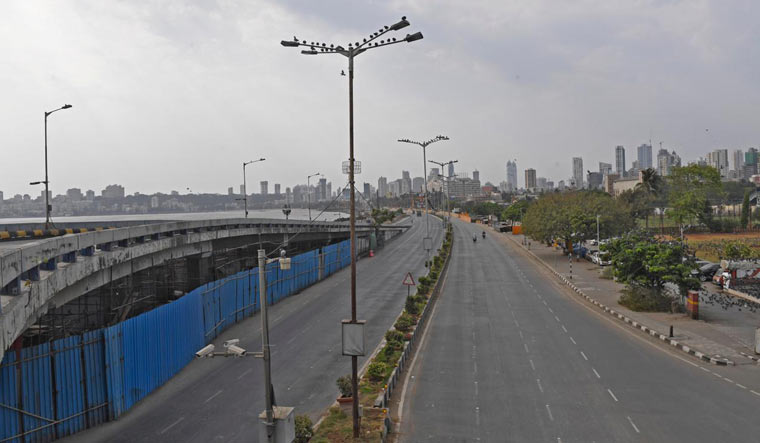The second wave of COVID-19 infections in India presents a challenge to ongoing economic recovery, as the country witnesses a much higher caseload with new peaks of daily cases, deaths and positivity rates, said the department of economic affairs in its monthly economic review.
But, it added a note of optimism saying there were reasons to expect a muted economic impact of the second wave compared to the first wave.
“The experience from other countries suggests a lower correlation between falling mobility and growth as economic activity has learnt to operate ‘with COVID-19.'"
On India's strategy, the report noted the five-fold strategy to curb the tide of new COVID cases—Test, Track, Treat, COVID appropriate behaviour, and vaccination. “A dynamic and concerted policy response to the second surge has been initiated with ramping up health infrastructure, oxygen supplies and deregulating the vaccine availability for all Indians above the age of 18 from May 1, 2021. With the second wave of COVID-19 infections forcing localized or state-wide restrictions, there is a downside risk to growth in the first quarter of financial year 2021-22.”
In its outlook for the coming months, the department of economic affair’s monthly review for April said, “Consumer confidence for the current period has weakened in March 2021 as the current situation index (CSI), as per RBI Surveys, dipped on the back of deteriorating sentiments on general economic situation, income and prices. Respondents, however, expressed optimism for the year ahead, which was reflected in the future expectations index (FEI); one year ahead sentiments on all major parameters except prices, however, remained in positive terrain.”
“With higher essential spending as compared to a year ago, most consumers reported higher overall expenditure, which is expected to increase further in the coming year despite continuing moderation in discretionary spending."
The RBI’s 28th round of services and infrastructure outlook survey (SIOS) conducted during January-March 2021 indicated "some moderation in the overall business situation and turnover in Q4 FY20-21 after a pace of strong recovery in Q3. Nonetheless, respondents exuded optimism regarding the business situation, employment conditions and turnover for Q1 to Q3 of FY 21-22. Infrastructure companies were optimistic about Q4 of FY2020-21 expecting a sharp uptick in the overall business situation."
The review said rapid vaccination lends a ray of hope.
“The global economy recovered further in March and April, powered with vaccination drives and fiscal stimuli by few large economies. In April, due to the second wave in India, the momentum in economic recovery since the first wave has moderated.”
Like last year, agriculture continues to be the silver lining with record foodgrain production estimated in the ensuing crop year on the back of predicted normal monsoons. In addition, rural demand indicators like tractor sales recorded a growth of 172 per cent and 36 per cent compared to a low base in March 2020 and even the pre-COVID month of March 2019 respectively.
However, industrial production showed mixed trends. While Index of Industrial Production (IIP) in February 2021 registered a broad-based decline of 3.6 per cent (YoY) and 3.9 per cent compared to January 2021, the eight-core index posted growth of 6.8 per cent (YoY) in March 2021 and 11.1 per cent compared to February 2021.
In FY 2020-21, the core sector contracted by 7 per cent compared to 0.4 per cent growth in FY 2019-20 with fertilizer being the sole growing sector and electricity recovering steadily in the second half.
The review cited that the Purchasing Managers Index for manufacturing rose further to 55.5 in April with consumer goods as the strongest-performing category, followed by capital goods and then intermediate goods.
India’s power consumption registered a growth rate of 40 per cent in April 2021 over April 2020 and 6.5 per cent over April 2019, signalling sustained industrial and commercial activity. In terms of value, e-way bills generated reached Rs 17.36 lakh crore in April 2021 compared to Rs 3.9 lakh crore in April 2020 and Rs 14.8 lakh crore in April 2019—the growth since April 2019 is an indicator of the increased formalisation of the economy.
“Power consumption and e-way bills have shown some sequential moderation in second half of April resulting from localized movement restrictions. Railway freight continued to register double-digit growth in April compared to the low base last year and more than 10 per cent growth compared to April 2019,” the report added.
Referring to other indicators, the review said that automobile sales, buttressed with pent-up demand and preference for personal vehicles, demonstrated a strong YoY recovery of 115 per cent in passenger vehicles and 71 per cent in two and three-wheelers in March 2021 over the low base of March 2020 due to the onset of the pandemic.
The review report said, “softening food and fuel prices, with normal monsoon and expected supply easing of food products, may provide succour to a potent risk of rise in input prices surfacing as retail inflation.”





